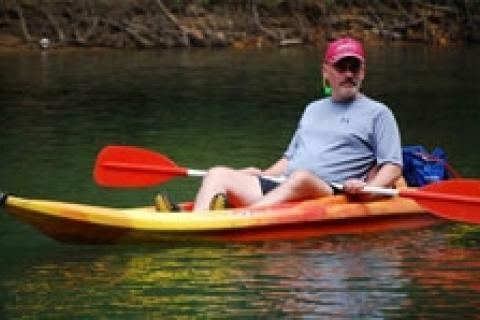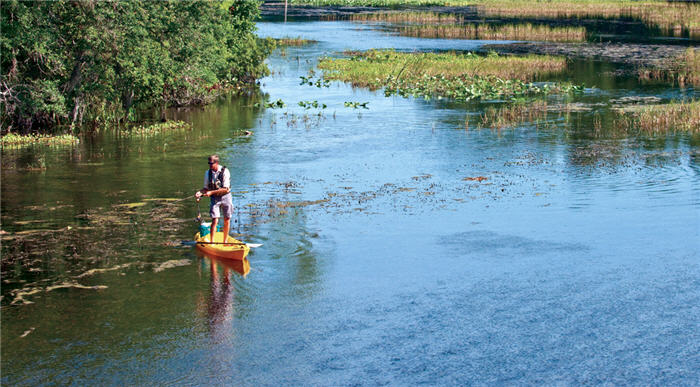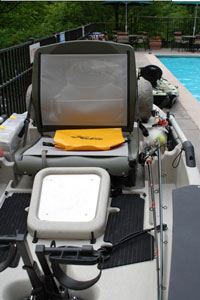
Kayak fishermen have taken their sport to a new level. Interest blossomed a decade ago, and the idea of fishing from a kayak has grown by leaps and bounds. However, making the right choice for a fishing kayak involves some considerable forethought and experimentation. These pointers will help.
Take a look at the charts below to help you determine which kayak is best for your fishing needs.

How to Start Kayak Fishing
Individuals wanting to purchase a kayak for fishing must first consider their own physical characteristics, i.e. height and weight. This a key factor in selecting a kayak. A large, heavy person will need a kayak with more beam and length than an individual of small stature. A large person will need a kayak with a larger cockpit opening for ease of entering and exiting the craft, while anglers with smaller frames will fare better with a smaller cockpit opening.
Transporting Your Kayak
Take into consideration the type of vehicle you drive and how far you must travel to get your boat in the water. Lifting a long, heavy kayak to the top of an SUV can be a real struggle if you are alone. If your kayak fits into the bed of a pickup truck, loading and hauling will be simple. Otherwise, you need to plan on having someone assist you with placing a kayak on top of a vehicle. If you travel alone, a kayak trailer may be the best choice for longer, heavier models.
 |
| Sit-on-top kayaks are becoming more popular with fisherman. |
Getting to the Water
A common mistake made by kayakers is not knowing in advance out how they will get their kayak to the water once they reach their destination. Lighter models are obviously easier to portage. Otherwise, a cart for heavy models will be necessary. As a last resort, dragging is an option. Check the route first, however, to avoid damaging the hull on abrasive materials.
Protect Your Backside
Sit in the seats of several kayak models before making your decision. Does it fit your bottom comfortably? Does it give you good back support? Remember, you will be in the craft for long hours and will only be able to stand up when you stop for a break. Next to design of the craft, a comfortable seat is the most important feature.
Which Kayak Style is Best?
Traditional kayaks are also known as sit-in kayaks. They resemble canoes in that you sit inside on a seat mounted to the hull. Sit In kayaks offer more protection from the elements, but may take on water unless one uses a spray skirt. The skirt goes around you and the opening to prevent water from entering the craft. A skirt also limits access to items stored inside the kayak.
 |
| Kayaks now come with all the bells and whistles a fisherman could ever want. |
Sit-on-top models are a recent development in kayaks designed to allow the boater to sit on top. They look somewhat like a modified surf board. They are equipped with scupper holes, which allow water to drain from the cockpit.
Both types of kayaks are very useful to anglers. There are many models in each category allowing every procrastinating buyer to pick and choose the features which best suit their individual needs and desires.
Style of Fishing
Your personal fishing style will largely determine the style and size of kayak you will need. Questions to ask include: What type of water will I fish? Small streams, lakes, the ocean? What style of fishing will I employ? Flyfishing only, baitfishing (live or dead), lures only? Will I practice catch and release fishing or bring fish home?
Each of these questions will add or delete features from the kayak you choose. You can get by with a shorter kayak on smaller bodies of water. You will obviously want a much longer ocean going kayak for saltwater species and rougher waters. Need a place to store fish you catch or live bait? Some models have small live wells, as well as rod holders. A longer kayak will be needed to store long rods such as flyrods. The bottom line is that you can pick a lot of options which can be added to build teh kayak you want. Hobie is especially adept at add on features.
So Many Kayak Choices
That is one benefit of a free market and you, the buyer, can take advantage of the best deals. Keep in mind, particularly if you are a first time buyer of a kayak for fishing, you should start out simple. Don’t break the bank to get the biggest, most elaborate kayak on the market. Kayaks hold 50 to 80 percent of their market value for a couple of years, so consider upgrading once you gain some experience.
My wife and I have enjoyed Old Town kayaks for fishing Ozark streams for years. She has a pink Otter Sport, while I float a dark green Rush. She wants to look cool. I want to catch fish. Still, most times she out fishes me. The kayaks are identical in length, width and weight, but are arranged differently. I carry more gear. I think she planned it that way.
Others to consider are the Hobie Mirage Pro Angler, Old Town’s Vapor 12XT Angler and Ascend's Angler Kayak comes in several models sure to please anyone.
Take a Kayaking Class
Kayaking classes are offered by many park and recreation departments as well as kayak retailers and outfitters. Classes are always taught by professional kayakers who can easily teach you paddling methods, safety on the water and care of your kayak.
Study
Charts to help you determine which kayak is best for your fishing needs.
Shorter Kayaks |
Longer Kayaks |
| Easier to maneuver. | Easier to paddle over long distances than shorter boats (once you get them up to speed). |
| Able to make quicker turns. | Able to hold a straight line better to stay on course. |
| Best for estuaries, small lakes, rivers; less suitable for long trips. | Best for open water; good on smaller bodies of water. |
| Weigh less | A bit heavier |
| Less affected by winds. | Able to carry heavier loads with less performance loss. |
| Less cumbersome to transport. | Glide farther per stroke for greater efficiency. |
| A bit slower | Move faster |
Width (or Beam)
Wide boats offer more initial (primary) stability in calm conditions while narrower boats go faster and offer better secondary stability if the boat is leaning on its side.
Narrow |
Wider |
| Easier to tip | More stable |
| Easier to roll upright after capsizing. | Easier to get in and out of. |
| Less room for gear. | More room for gear. |
| Lighter weight | Heavier |
| Tracks better | The wider it is, the slower it is. |
| More efficient to paddle through water. | Requires more effort to paddle because it's pushing more water and is heavier. |
- 4716 views

